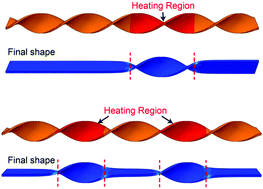Thermomechanics of a temperature sensitive covalent adaptable polymer with bond exchange reactions
Abstract
We study a covalent adaptable polymer that can rearrange its network topology through thermally activated bond exchange reactions. When the polymer is deformed, such a network rearrangement leads to macroscopic stress relaxation, which allows the polymer to be thermoformed without a mold. Based on a previously developed constitutive model, we investigate thermal–mechanical behaviors of this material under a non-uniform and evolving temperature field through numerical simulations. Our focus is on the complex coupling between mechanical deformation, heat conduction and bond exchange reactions. Several examples are presented to illustrate the effects of non-uniform heating: uniaxial tension under heat conduction, torsion of a thin strip with local heating and thermal imprinting. Our results show that during non-uniform heating the material in the high temperature region creeps. This causes a redistribution of the deformation field and thus results in a final shape that deviates from the prescribed shape. The final shapes after thermoforming can be tuned by controlling the extent of heat conduction through different combinations of heating temperature and time. For example, with high temperature and a short heating time, it is possible to approximately confine stress relaxation and thus shape fixity within the local heating region. This is not the case if low temperature and a long heating time are used. These results can be utilized to design the temporal and spatial sequences of local heating during thermoforming to achieve various complex final shapes.


 Please wait while we load your content...
Please wait while we load your content...